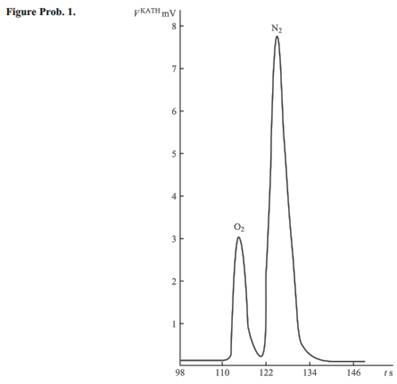A sample containing oxygen and nitrogen is injected into a helium carrier at time t = 0. The sample is swept through a column 1.0 m long packed with molecular sieve. The eluting components are detected by a katharometer detector which has an equal sensitivity for oxygen and nitrogen. The time variation in katharometer output voltage is shown in Figure Prob. 1.
(a) Assuming that the distribution ratio K for oxygen is 2.0, estimate the mean carrier velocity ó and K for nitrogen.
(b) Estimate base width ∆t for both peaks and hence find the resolution R.
(c) Estimate the number of theoretical plates N and HETP.
(d) Estimate the percentage composition of the sample (assume peaks are approximately triangular).

1. Sixteen analogue input voltages, each with a frequency spectrum between 0 and 5 Hz, are input to a time division multiplexer. The multiplexed signal passes to a serial digital (PCM) transmitter consisting of a sample/hold device, 12-bit binary ADC and a parallel-to-serial converter. The PCM signal is transmitted to a distant receiver over a link affected by ‘white’ noise with a power spectral density of 0.2 mW Hz−1 .
(a) Suggest a suitable sampling frequency for each input signal.
(b) What is the corresponding number of samples per second for the multiplexed signal?
(c) What is the maximum length of time the sample/hold device can spend in the hold state? (d) What is the maximum percentage quantisation error for the ADC?
(e) Find the bit rate and minimum transmission bandwidth for the PCM signal.
(f) The first stage of the PCM receiver is a low-pass filter with a bandwidth ‘matched’ to the frequency spectrum of the PCM signal. Estimate the standard deviation of the noise present at the filter output.

